July 31, 2019 | Day 3, Session 5 (The Grand Finale!)
Note: Gerry did not disappoint. He’s funny as shit and his accent is delightful and his screenshots had hidden little nuggets in them that made the entire room burst out in laughter. Thank you from the bottom of my heart, Gerry, for the giggles you gave today.
A little shart about Gerry: He has clients like CISCO, IBM, The United Freakin Nations, organizations large and small. He helps those organizations to focus in on what their users or customers want from them and delivering that.
What matters to us as humans is our sense of independence and our sense of control. As we get older we may start to lose a certain amount of that control .
So in the care industry when people are helping often older people, the sense of control and independence is central to these people they’re trying to help. but in the typical industry mindset and how these sectors are managed, this sense of control is ignored or taken away.
Oftentimes these industries focus instead on the person giving the care (the nurse, or whatever). He was watching a documentary about home help / healthcare industry in Holland where a nurse bent down to tie a patient’s shoe and said “I am now delivering product number 67.”
Everything had been measured about what this ‘nurse’ was actually doing and in that process they had lost the whole essence of why they were doing it or what the overall purpose was.
Case Study: Buurtzorg is an organization that decided to do something very radical and instead of putting the organization at the center they put the person at the center and said ‘what matters most to them?’ It’s their independence. They don’t want somebody tying their laces for them if they can avoid it. Ok, so that’s what these people want so that’s what we’re going to measure.
The core metric and goal became to help people live independently, which changed the scope of the actual job of being a nurse in this industry. So the nurses started creating networks around the person. The first network they created was the informal networks (neighbors, children, people in the community that may actually support them). But nobody every did that because nobody ever had time – everybody’s time was segmented up into minutes and segments. So then the Buurtzorg team (the nurses themselves) were the next network, and the final network was the formal network of the hospital, and that was the last resort.
This organization started off in 2008 with 4 nurses. Now it has 14,000 nurses in the Netherlands and they have no managers in Buurtzorg. Buurtzorg central team has only 15 people in the central office. They make groups of 14 nurses that work together to solve problems and meet the core overall metric is independent living.
That model has the highest patient satisfaction in the Netherlands, the highest employee satisfaction and the lowest cost. They’re the most profitable nursing org in the Netherlands. They also cure patients faster than their peers do.
If somebody’s laces are untied for a certain amount of time, they think about the issues behind why the laces are untied and say ‘hey let’s go to the eye doctor, or let’s go to yoga,’ so they’re addressing the problem in a holistic way.
This is the core change on a global basis on new organizational thinking.
Their golden rule is that nurses must open at least 60% of their time with the patient. They don’t have a research team – they don’t need one, because their nurses are WITH their patients so they KNOW the information!
We manage what the customer is obsessed with – we find out what is most important to the customer and we focus on that.
GOOGLE
So let’s take this into a digital realm and find organizations that have similar thinking, we see Google.
From the beginning Google’s principle was to focus on the user and the rest will follow.
So you don’t focus on search – you don’t care about the search results, what you’re interested in is ‘how am I able to get the answer to the person as quickly as possible?’
So 5 or 10 years ago if you were searching for Dublin weather, and you’d get results and you could click on the first or second result and then on that page you’d see weather. That took about 20 seconds.
About 3 or 4 years ago, the answer itself comes onto the the page itself! Because we’re NOT LOOKING FOR SEARHC RESULTS! We’re looking for the weather! This is down to around 9 seconds!
So Google is not managing the search results page, it’s managing the answers.
So new advances in HTML come out and they ask ‘how can this help us get answers more quickly to people.
If they were a traditional ad-driven company they’d put the answer on the second page of search results because it gets more clicks!
But now in Chrome you don’t even have to type all the text, it auto-fills and shows you the temperature in the auto-fill results! This is just SECONDS!
A traditional company would say ‘what a stupid idea! they’re not even going to your page!’
But now Google stays as the #1 place you go to for the answer.
They’re measuring success based on YOUR success first and foremost.
Google’s homepage over time has gotten simpler over time! They got rid of the tabs, they made the search box bigger, now there is only a logo, a search box, and 2 buttons! They go RID of advanced search!
They know what you’re looking for, and they put it on the page! It does the advanced things FOR you!
If you ever have to talk about simplicity, you’re living in a world of complexity. If it’s easy, you just do it! If you have to write content about ‘it’s simple’, it’s not.
If Google were run like a typical company, the website would look like this mess!
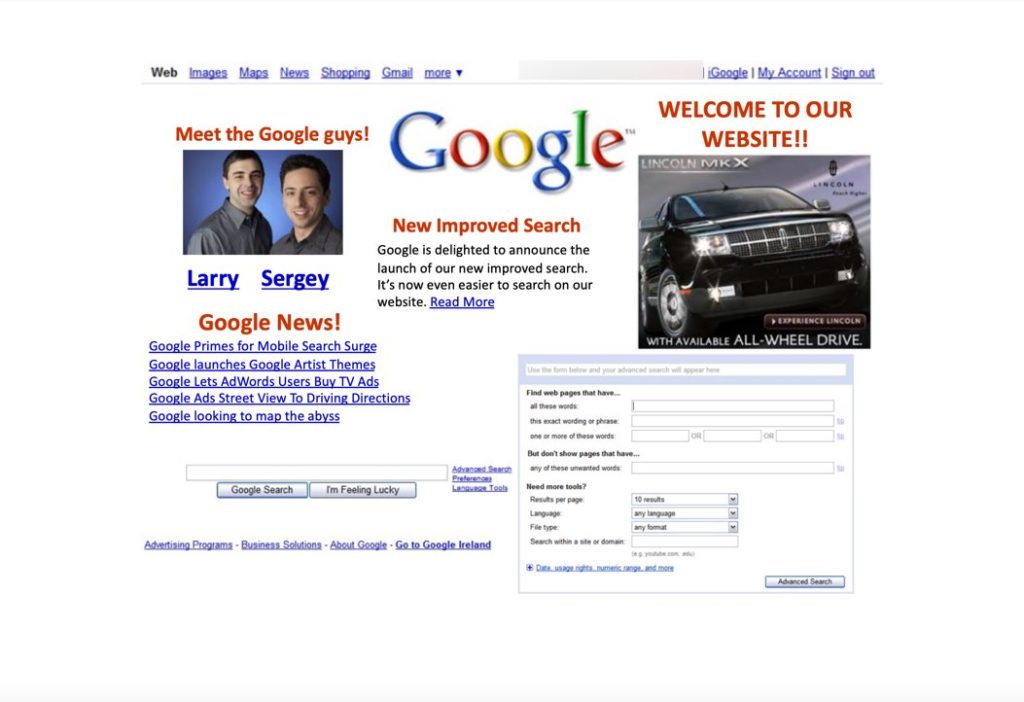
If Google wanted to get found in Google, what kind of page would you have to create?
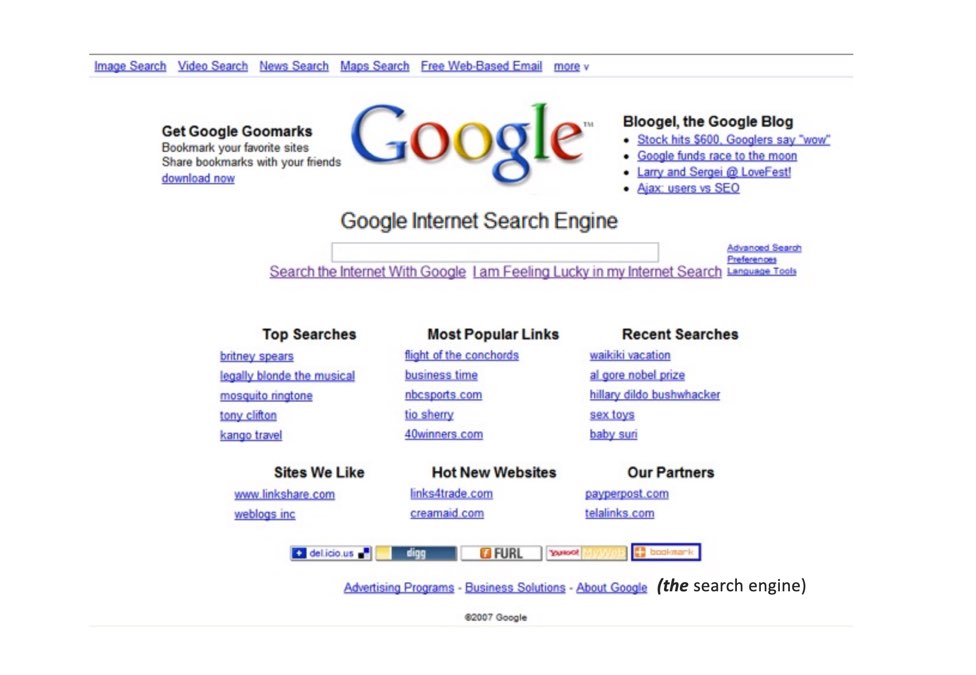
Be very careful of these old traditional strategies.
How does Google maintain this culture?
Field Fridays: Once a month, developers at google search go out and actually meet and chat with people who use their search engine.
It has been difficult to maintain that degree of simplicity. But it can be profitable.
AMAZON
Amazon is another example of an org obsessed with the customer.
Amazon changes its an environment an average of every 12 seconds.
They are constantly testing and iterating and focusing on what people are doing.
Agility is more the focus rather than agile, the ability to respond to customer behavior.
Customers are moving faster today that most organizations are. Customers are changing at a higher speed than most organizations are. The orgs that are keeping up are the ones that are constantly changing.
The old model used to trust leaders and have the organization at the center.
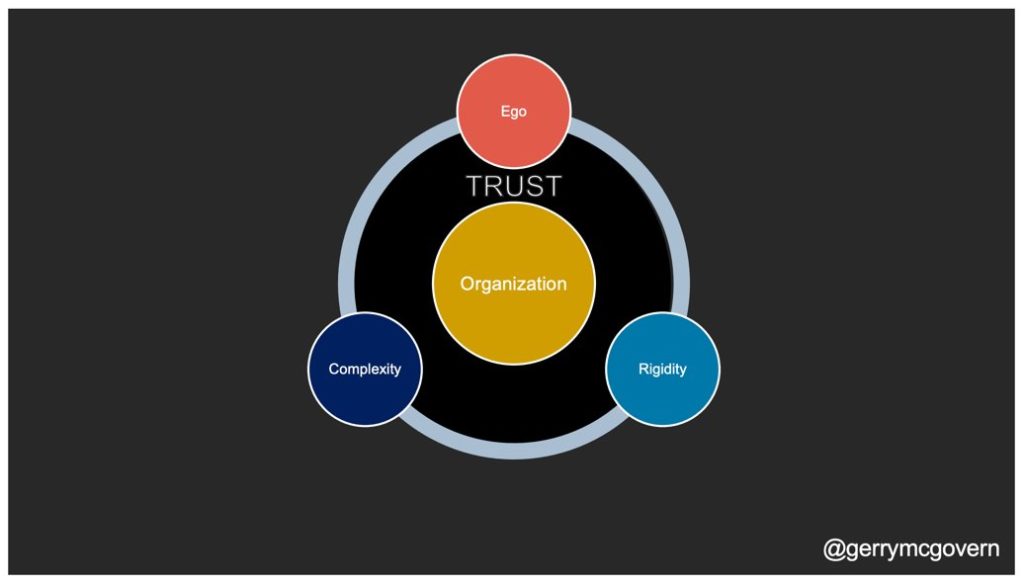
This old model is being challenged by young people.
There has been a collapse of trust in multiple countries in traditional organizational models like religion and politics. It hasn’t disappeared, it has just shifted.
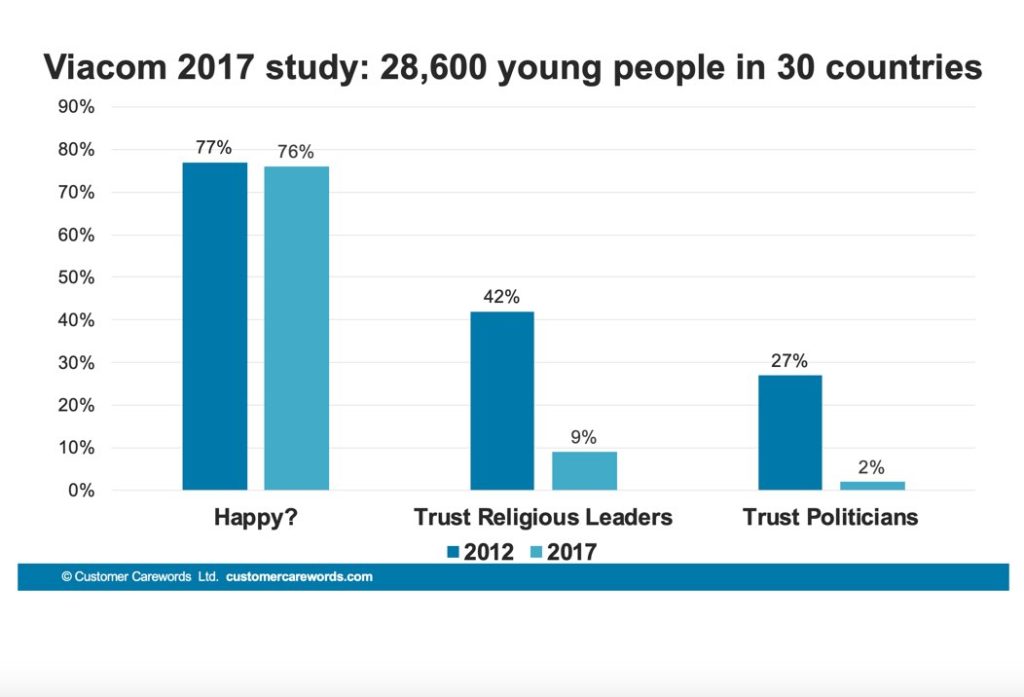
So, why do we trust strangers? Why do we get into Uber and stay in strangers’ houses? Trust has shifted into a different model.
Why do models like Uber and Airbnb work? Do they work because we trust AirBnb management? No, it’s because we trust the people who use these things. We trust those who use the actual thing. Trust has moved to use.
There’s a shift in many societies from looking towards a brand and a leader to those who use that thing.
It’s like there are 2 worlds operating together – the old world is still out there but the new world is too.
The foundational principles of new organizations are humility, simplicity, and agility.
Humility, Simplicity, and Agility
HUMILITY
Humility is not weakness – it’s the ability to accept that you don’t know all the answer and that we need to work and collaborate with other people to achieve success in a process.
In a study, it was found that a hotel receptionist that is black had to smile far far more than one who was white to get the same friendliness rating! We have these inherent prejudices that we don’t even think about.
We typically have empathy for people who are like us but we often don’t consider people who are outside our peer group.
You can’t achieve anything in science alone.
As the world becomes more complicated, you cannot achieve anything on your own or even in your own peer group.
There was a paper published by Cern that involved 5000 authors! It didn’t just include physicists but had the involvement of philosophers, etc to widen.
In the 80s / 90s something happened to explode the amount of authors in scientific papers.
What happened? THE WEB
The web is a connective environment that brings people together. Science used that new network to collaborate far more, and as a result of that, the human genome was decoded in 5 years instead of the 50 years they expected, because they were able to share the task out among thousands of institutes and bring those results together.
Another study has found that multi-cultural collaborative science is delivering higher productivity.
Bringing together people from other cultures isn’t a NICE thing to do, it’s a SMART thing to do! But it requires humility.
Multidisciplinary science results in more innovations.
Bringing together a whole network of people results in more innovations!
Case Study: Working with a city government to improve the website to help citizens find what they wanted. Silos have great beneficial roles to achieve activities, and the designers involved in a project to make it easier for citizens to find the information they needed. So the designers’ goals were to create bridges in between the silos.
Often today, good design is a bridge-building exercise within the organization.
Microsoft was very silo-based. To change the model they changed the metric of how Microsoft people are being measured. It used to be all about what you produce, what you create.
Before the metric was ‘Your career will advance if you create a new feature or product.’
Today, 1/3 of your review is based on what you create. Another 1/3 is based on what you share. The final 1/3 is based on what you use (how have you used other things that have been created?).
They’re shifting the culture away from just being production-based. These new models of management are beginning to emerge slowly but surely in many
Jared Spool has constantly talked about exposure hours, spending time with your customers. 2 hours with customers every 6 weeks as a minimum requirement for success.
Tote was an ecommerce app for iPhone that wasn’t very successful. And the founders were obsessed with figuring out what their customers (not very many of them) were doing. They found that the one thing that was happening is people were creating catalogues of shoes and clothes and sharing those with other people… so they created Pinterest.
Glitch was a simple multi-player game that wasn’t very successful, but they came up with an internal tool to help them communicate about development, and they created Slack out of it.
YouTube started as a video dating site. Many things on the web started out as something different than what they became.
These are the marketing myth that we are told – Steve Jobs went to the top of a mountain and did yoga and then out popped the iPod. Apple was always the most customer-driven company in the technology industry. Apple would sometimes review 50 different refinements of a single hardware button to get the right thing. Constantly doing market research and designing true use in the environment.
Most websites you go to shows you what the Org wants the customer to do everywhere. There’s organizational arrogance all over it.
That model isn’t successful anymore and yet we keep repeating it because we’ve done it for 50 or 70 years. There is another model, and it works – putting people’s need in the center of the process.
AGILITY
Agility, the ability to adapt.
Your ability to respond to your customers is how you measure agility in a particular environment. Feedback is crucial in any kind of agile environment.
With print, the time and cost to print a book decreased. One of the things it caused was a revolution in mapping. Mapping advanced more in 28 years than it had in the last 500 years because the technology allowed them to send out maps and get feedback much quicker.
Google Maps changes 10,000 times a day. You give feedback to Google Maps that they missed a roundabout, they check against other data, and if they really missed it and it’s there they can add that roundabout to the map in 20 minutes.
Our experience is not everybody’s experience. We need humility and feedback to take in that there are many different world-views.
We need this constant feedback in order to actually create better and more refined products.
Google launched this thing where if you click ‘walking direction’ it shows you how many calories you’d burn in that time and use ‘pink cupcakes’ as a metric to how much those calories represent. They got a lot of negative feedback REALLY FAST (instant feedback online, via feedback links, via Twitter). It took 1 hour to document the flaws and it took 3 hours to take the feature down.
“We’ve only dug a little hole for ourselves, we have to dig it MUCH bigger. It has to stay open for at LEAST 6 months! Look at how much money we spent on it!” That’s how most organizations behave. The really successful organizations are willing to learn from their mistakes.
If the web was a digestive system, it would have no capacity to poop.
It just gets bigger and bigger and bigger.
IMAGINE IF CONTENT SMELLED
If you came in in the morning and opened your computer and were blown back by a rotting smell and you think ‘oh Lordy, I’ve gotta go delete those old pages!’
Digital is such a dark, empty space. We never get enough feedback. Many of the more progressive organizations they’re looking at ways to create a feedback environment that brings feedback environment INTO the organizations so we can see and feel what happens to the customer in the digital space.
Toyota has developed Simon, an orb type machine with lights and colors hooked up to the metrics of the website and it goes red when page speed is too long and people care about it!!
Finding ways to bring the experience of your customers outwards to the organization is very important. To create physical representations or artifacts of the customer experience is important.
SIMPLICITY
The value of simplicity –
Gerry got to work with the company that made the damn milk cartons nobody could open EVER. He asked why they did it – they said operational efficiency. Their objective as engineers were to get as many cartons in the box and the most boxes on the shipping item as possible. That was their goal – cost efficient and cost reduction in the process. They didn’t care that the customer had a hard time opening the milk!
But they care today. Now there’s a screw-cap and cartons are easy to open.
And why do they have to care today when they didn’t 15 years ago? Customers have changed.
We are dealing with customers with higher and higher opinions of themselves and lower and lower opinions of organizations.
So there’s been a big shift in psychology of customers and acceptance of poor service.
AirBnb did some silly stuff with the website in 2015 and 2016, and they ended up just doing what they should have – put the booking form right up front because that’s all people want to do – book a damn room.
They had a horrible form they helped simplify – and that simplicity resulted in a huge drop in tickets opened and support calls (over 50%). Simplicity results in huge organizational value but we HAVE TO MEASURE IT.
Gov.uk has done tremendous work. They looked at a long, convoluted page and reduced it to literally one sentence. They had 50 pages of content with 1 tool, 1 transaction, and they turned it into a yes/no question, a logic-tree.
We can simplify so much stuff and it delivers SO MUCH VALUE in the process.
This is the challenge – the balancing act we have. If we push so much complexity onto the user, they will avoid using us or it undermines the credibility of the organization or agency. The credibility and trust collapses.
What we’re looking for is a balance where there’s enough simplicity but the complexity doesn’t overwhelm us internally. We get here by constant iteration, by designing with people instead of for them.
Humility, agility, and a focus on simplifying to the point (not beyond it) where the maximum value can be achieved.
@gerrymcgovern
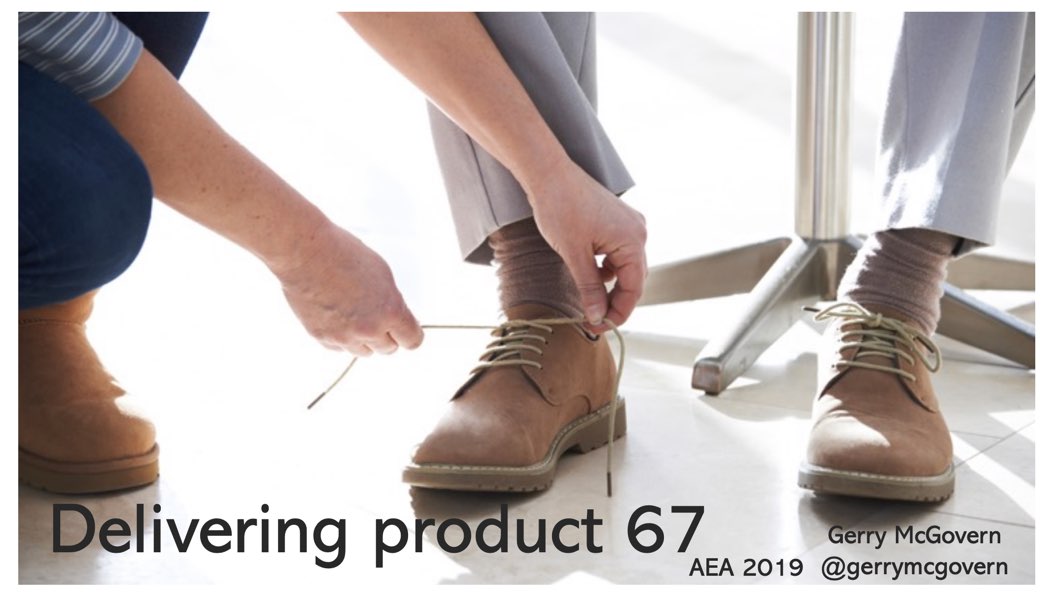






0 Comments